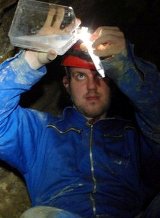Practical Considerations
This section is under construction (July 2010)
A number of practical limitations due to the choice of organism and/or growth substrate used can affect growth in chemostat culture and should be considered and, where possible, overcome in order to maximise the stability of the culture.
Wall Growth
Biofilm growth on the walls of the culture vessel and on outflowing tubing can result in a chemostat culture that is essentially useless for any form of kinetic work. Glass surfaces can be rendered hydrophobic by an application of a silanising agent, such as dichlorodimethylsilane (typically purchased as a 2% solution in an organic solvent). Silanising glass is a simple procedure but best carried out in a fumehood since hydrogen chloride gas is evolved. The culture vessel should be washed thoroughly with detergent and then rinsed with MilliQ water before drying with a tissue. A dichlorodimethylsilane solution is applied using a tissue to all surfaces, paying particular attention to the overflow, and allowed to act on the glass for 15 minutes. In the case of small growth vessels, it is usually more convenient to fill the vessel with silanising solution, leave for 15 minutes then empty. The treated vessel should be washed in hot water containing detergent and dried before autoclaving. One silanising treatment is usually sufficient to last for several months of growth.
Foaming
Cultures maintained at a high OD or that are growing on substrates such as sugars or glycerol are particularly prone to foaming. Certain members of the Bacteria produce extracellular polysaccharides that can increase foam production - such as Xanthobacter spp. The main effects of foam on a chemostat culture are (1) altering the efficiency of the culture overflow, resulting in altered flowrates and (2) introducing heterogeneity to the culture.
Many bioreactors are manufactured with automated foam-control systems which consist of a pair of electrodes - one under the surface of the culture and one held a few centimetres above the surface. In the even of foam being produced, a circuit between the electrodes is completed and a controller introduces a defined volume of an antifoam agent into the culture, dispersing the foam. Since prevention is always better than cure, antifoam can be added directly to the inflowing medium prior to autoclaving, effectively preventing foam formation. 0.002% (v/v) silicone-based antifoam (i.e. 20µL per litre of medium) is sufficient in most cases. Antifoaming agents come in two basic types - a type that is virtually immiscable in water and must be emulsified (e.g. Antifoam A) and a soluble type (e.g. Antifoam 289). In my hands, the soluble varieties are easier to work with and give more efficient results.
pH Control
All bioreactor systems have pumps for acid/base and a pH probe to keep the culture at a constant pH during growth. It is generally most practical to use quite concentrated acid and base since the reservoirs will not need refilling very often, but this should be done with care as strong acid/base can damage tubing and kill cells upon contact with the culture. 2M hydrochloric acid and 2M sodium hydroxide are generally suitable, though, if working with an organism that, for example, produces sulfate as its metabolic end product (e.g. Thiobacillus thioparus grown under thiosulfate-limitation), use of sulfuric acid (1M) is suitable. For organisms grown under "marine" conditions, hydrochloric acid/sodium hydroxide can be unsuitable as they will increase the NaCl concentration in the medium. Avoid the use of carbonates as bases when growing autotrophs - they provide an additional carbon-source!
Tubing
For most applications, silicone tubing is sufficient, however, it should not be used for growth under anoxic conditions or when efluent oxygen is to be determined since it is permiable to oxygen. When working with volatile compounds such as sulfides or aromatics, silicone tubing is, again, not suitable. For these applications, tubing such as Viton® is more useful, albeit expensive.

Rich Boden
Rich dot Boden at warwick dot ac dot uk

